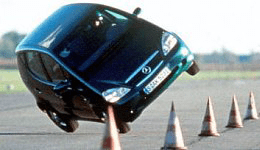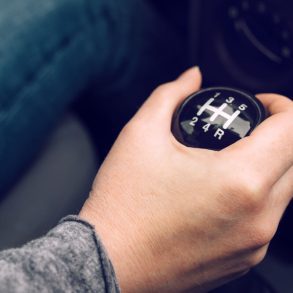Remember the Moose Test that almost killed the Mercedes-Benz A-class?
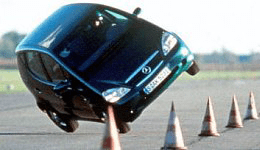 In 1997 Mercedes had introduced a revolutionary new car, the A-class, Mercedes’s first entry into the compact car segment. Mercedes proclaimed it would be the safest compact car on the market. Shortly after the car was officially introduced, it rolled-over during a test known as the “moose test“, conducted by a Swedish journalist. The A-class’s failed moose-test created extensive media coverage in Germany and other European countries, threatening the success of the A-class launch and hurting the safety image of parent Mercedes-Benz. They were forced to make an Electronic Stability Control system ESP as standard, and then it passed the test, but the damage to the A-class’s image had been done.
In 1997 Mercedes had introduced a revolutionary new car, the A-class, Mercedes’s first entry into the compact car segment. Mercedes proclaimed it would be the safest compact car on the market. Shortly after the car was officially introduced, it rolled-over during a test known as the “moose test“, conducted by a Swedish journalist. The A-class’s failed moose-test created extensive media coverage in Germany and other European countries, threatening the success of the A-class launch and hurting the safety image of parent Mercedes-Benz. They were forced to make an Electronic Stability Control system ESP as standard, and then it passed the test, but the damage to the A-class’s image had been done.
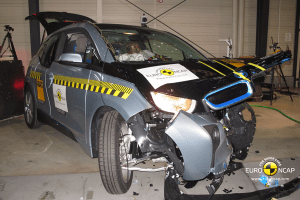 Fast forward to 2013: BMW introduces a revolutionary new car, the i3, BMW’s first entry into the electric car segment. BMW proclaimed it would be one of the safest electric cars on the market, thanks to its carbon fibre safety cell. Shortly after the car was officially introduced, it received only a four-star rating in the European safety test, conducted by Euro NCAP. The i3’s “failed” safety test created extensive media coverage all over the world, with BMW hoping it won’t threaten the success of the i3 launch and hurt the technology leader image of parent BMW. They probably will have to make a few safety systems as standard to get a five star rating, but the damage will have been done.
Fast forward to 2013: BMW introduces a revolutionary new car, the i3, BMW’s first entry into the electric car segment. BMW proclaimed it would be one of the safest electric cars on the market, thanks to its carbon fibre safety cell. Shortly after the car was officially introduced, it received only a four-star rating in the European safety test, conducted by Euro NCAP. The i3’s “failed” safety test created extensive media coverage all over the world, with BMW hoping it won’t threaten the success of the i3 launch and hurt the technology leader image of parent BMW. They probably will have to make a few safety systems as standard to get a five star rating, but the damage will have been done.
You see the similarities, right? Then why didn’t BMW see this coming?
What’s the problem?
According to the safety assessment agency, safety of the occupants, both adults and children, in the frontal impact test and the side barrier test was good, but the main reasons for the lower-than-expected result was pedestrian safety and the lack of a few safety systems. That’s just plain stupid by BMW, they know exactly what is required to get a five-star rating, but they failed to equip the car with the necessary systems to do that. Now they are suffering from a severe case of bad publicity.
As most people only read the headlines or just look at the star rating, and don’t bother to read the details. If they see anything less than a five star rating, they assume the manufacturer has failed to design a car that’s as safe as possible. Not surprising, since most newly introduced cars, like the Infiniti Q50, Mazda 3, Peugeot 308 and Mitsubishi Outlander PHEV received the highest score of 5 stars.
BMW should have known that.
No active hood
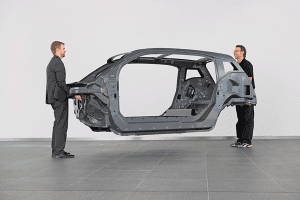 Designed with a carbon fibre safety cell for increased strength and rigidity, few expected the i3 to score less than the full five-star rating, BMW included. They had even been proudly praising the strength and safety of the i3’s passenger cell, which eliminated the need for a proper B-pillar. And because there is no engine underneath the hood, they also thought they could do without an “active hood”, as that would add extra weight to a car designed to be as lightweight as possible.
Designed with a carbon fibre safety cell for increased strength and rigidity, few expected the i3 to score less than the full five-star rating, BMW included. They had even been proudly praising the strength and safety of the i3’s passenger cell, which eliminated the need for a proper B-pillar. And because there is no engine underneath the hood, they also thought they could do without an “active hood”, as that would add extra weight to a car designed to be as lightweight as possible.
In the European crash test rating, cars are tested with a so called active hood if equipped with this system. Sensors detect when a pedestrian has been hit and the hood is automatically raised to provide greater clearance to the hard structures beneath. The i3 is not equipped with such a hood, which could have hurt its rating. So BMW took a gamble, but it didn’t pay off. However, they still could have scored the full five stars without the active hood.
Safety systems
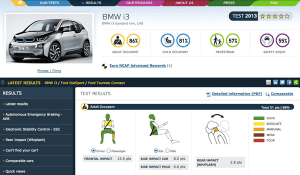 Because the category in which the i3 failed even more miserably was the Safety Assist category, and they should have seen this coming from a distance. BMW knows which systems are tested and evaluated by the rating agency, and they already have these systems in their other BMW models, so why did they refuse to add them to the i3? It may have been a weight issue, or a price issue, as the carbon fibre safety cell makes it a very expensive car to produce already.
Because the category in which the i3 failed even more miserably was the Safety Assist category, and they should have seen this coming from a distance. BMW knows which systems are tested and evaluated by the rating agency, and they already have these systems in their other BMW models, so why did they refuse to add them to the i3? It may have been a weight issue, or a price issue, as the carbon fibre safety cell makes it a very expensive car to produce already.
Still, they chose not to equip the i3 as standard with a driver-set speed limiter or a seat belt warning light for the rear seats. Are you kidding me? How much does that cost? Or weigh?
BMW responded by saying the i3 is equipped with some advanced safety systems, which are not yet tested and taken into consideration for the safety test rating. These include a (optional) pedestrian detection system which can bring the car to a full stop in city traffic when the system expects an imminent impact with a pedestrian or other object that the driver has not reacted to yet.
These kinds of safety systems will be evaluated and may become part of the crash test rating as early as next year, according to Euro NCAP. That’s nice, but BMW knew this and it’s too little too late to cry over this, when the headlines are screaming: “BMW i3 only gets four stars!”.
The importance of publicity
So BMW designed a car that’s very safe for the adults and children inside and offers average safety to pedestrians, but they forgot to take a lesson from the Mercedes-Benz A-class failure. To get a five-star rating, it’s not enough to build a car that protects the occupants in case of a crash. Safety systems are given high priority in the Euro NCAP safety rating as well, and BMW failed to keep this in mind when they chose not to equip the i3 with these systems as standard.
It’s extremely important for a revolutionary vehicle that’s bound to be scrutinized by press and public not to slip up in any way, as headlines can make or break a car for years to come.
How important are safety systems?
It’s a good thing Euro NCAP does not only test for crash test safety, but also for safety systems that help avoid accidents and mitigate injury. However, does it make sense to give these systems equal importance to passenger protection in the safety test? Currently, Adult Occupant Protection, Child Occupant Protection, Pedestrian Protection and Safety Assist are given equal weight, each accounting for 25% of the safety score. But does that mean that a car like the BMW i3, protecting its occupants with a strong and safe passenger compartment, is so much unsafer because it doesn’t have a rear passenger seat belt warning light and a driver activated speed limiter as standard?

